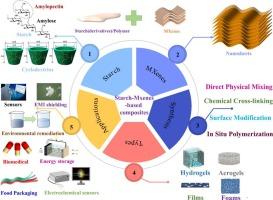State-of-the-art in starch (derivatives)/MXene-based composites for emerging applications: A focused review
IF 12.5
1区 化学
Q1 CHEMISTRY, APPLIED
引用次数: 0
Abstract
The synergistic integration of two-dimensional MXenes with starch matrices is propelling the advancement of next-generation technologies, as MXenes exhibit a broad specific surface area, exceptional electrical conductivity, and a wealth of surface end-groups that contribute to their impressive electronic, thermal, optical, and mechanical properties. Starch and its derivatives, known for being easily modified, biodegradable, non-toxic, and biocompatible, offer a compelling platform for designing hybrid composites with MXenes to maximize their functional capabilities. The interaction between starch (derivatives) and MXenes results in tunable mechanical strength and electrochemical properties of starch (derivatives)/MXene-based composites (SMBCs), positioning them as highly promising materials for a wide range of applications. Despite their potential, there remains a notable lack of comprehensive reviews on SMBCs. This review addresses that gap by detailing the various types of SMBCs (hydrogels, aerogels, films, and foams), and highlighting innovative preparation strategies, with a particular empHasis on their applications in sensors, electromagnetic interference shielding, energy storage, environmental remediation, biomedical engineering, food packaging, and electrochemical sensors. Finally, we outline the current challenges and propose future research directions for SMBCs, offering valuable insights and guidance for researchers, practitioners, and decision-makers in the field.

最新的淀粉(衍生物)/ mxene基复合材料的新兴应用:重点综述
二维MXenes与淀粉基质的协同集成正在推动下一代技术的进步,因为MXenes具有广泛的比表面积,卓越的导电性和丰富的表面端基,这有助于其令人印象深刻的电子,热,光学和机械性能。淀粉及其衍生物以易于修饰、可生物降解、无毒和生物相容性而闻名,为设计具有MXenes的混合复合材料提供了一个令人信服的平台,以最大限度地发挥其功能。淀粉(衍生物)和MXenes之间的相互作用导致淀粉(衍生物)/ MXenes基复合材料(smbc)的机械强度和电化学性能可调,使其成为具有广泛应用前景的材料。尽管中小型企业具有潜力,但仍明显缺乏对它们的全面审查。本文详细介绍了各种类型的smbc(水凝胶、气凝胶、薄膜和泡沫),并强调了创新的制备策略,特别强调了它们在传感器、电磁干扰屏蔽、能量存储、环境修复、生物医学工程、食品包装和电化学传感器方面的应用。最后,本文概述了中小微企业面临的挑战,并提出了未来的研究方向,为该领域的研究人员、从业者和决策者提供了有价值的见解和指导。
本文章由计算机程序翻译,如有差异,请以英文原文为准。
求助全文
约1分钟内获得全文
求助全文
来源期刊

Carbohydrate Polymers
化学-高分子科学
CiteScore
22.40
自引率
8.00%
发文量
1286
审稿时长
47 days
期刊介绍:
Carbohydrate Polymers stands as a prominent journal in the glycoscience field, dedicated to exploring and harnessing the potential of polysaccharides with applications spanning bioenergy, bioplastics, biomaterials, biorefining, chemistry, drug delivery, food, health, nanotechnology, packaging, paper, pharmaceuticals, medicine, oil recovery, textiles, tissue engineering, wood, and various aspects of glycoscience.
The journal emphasizes the central role of well-characterized carbohydrate polymers, highlighting their significance as the primary focus rather than a peripheral topic. Each paper must prominently feature at least one named carbohydrate polymer, evident in both citation and title, with a commitment to innovative research that advances scientific knowledge.
 求助内容:
求助内容: 应助结果提醒方式:
应助结果提醒方式:


